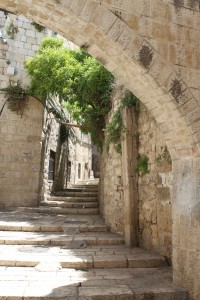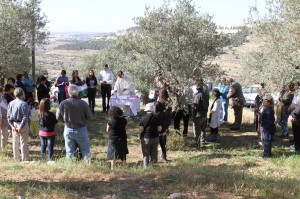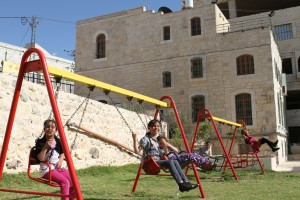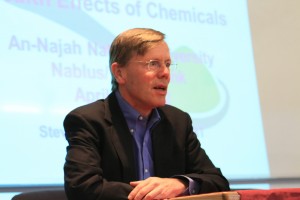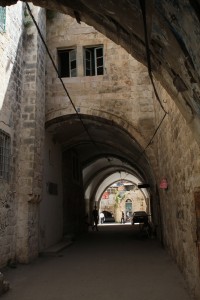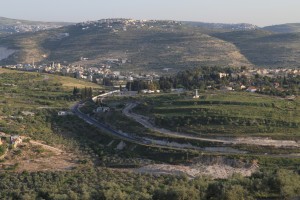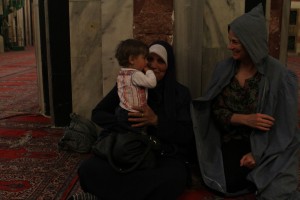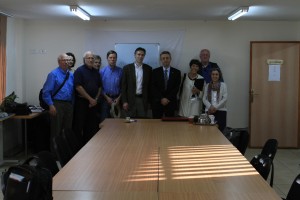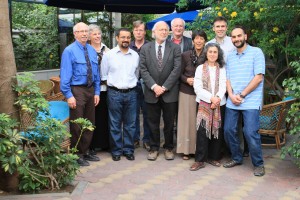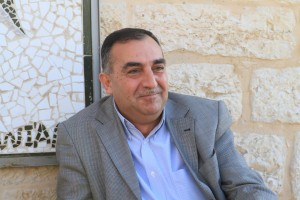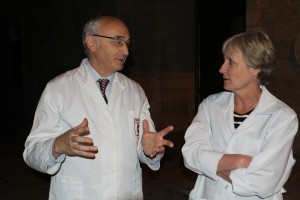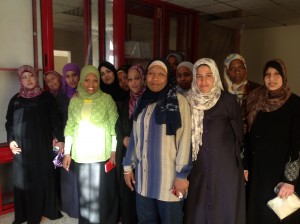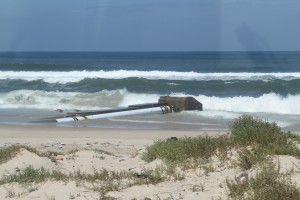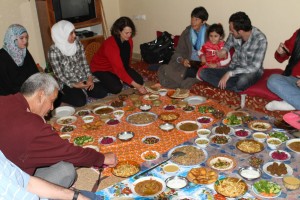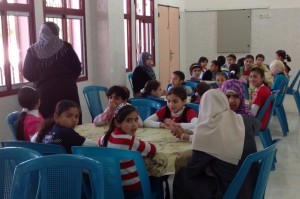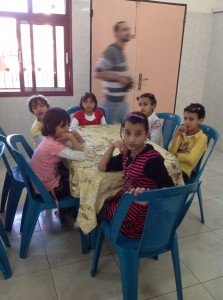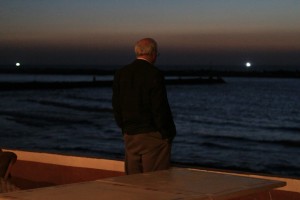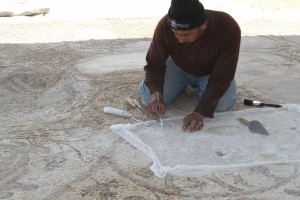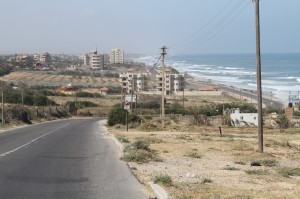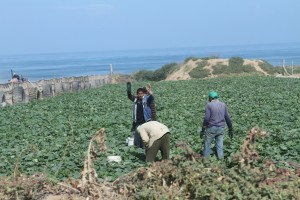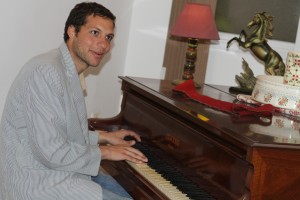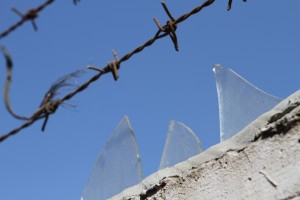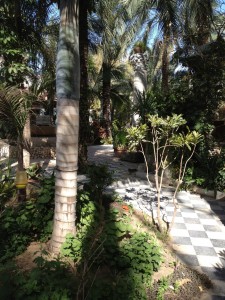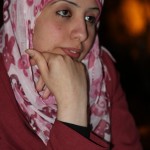(Gerri Haynes, a former president of Washington Physicians for Social Responsibility, is once again sending back reports from inside blockaded Gaza. As she did four times before, Gerri has organized a team of doctors and other health care providers to work in hospitals and clinics in Gaza in an effort to directly help the people there and to bring attention to the ongoing humanitarian crisis that the Israeli blockade has created. Eleventh in the series.)
Leaving the hills of Nablus this morning, our group exclaimed over the grace and generosity of the people we met in Nablus – a mayor who has his own fortune and works for the community as a volunteer, a scientist who found Steve Gilbert on the internet and set up a wonderful educational and cultural day for our group, Germans who have taken on the work of water treatment; the list is long and rich.
We entered Jerusalem (Al Quds) and enjoyed exploring the Old City while we waited to check into our rooms at the Notre Dame Center. The Old City, even on a quiet Friday, is full of aromas, music, colors, people. It is a fascinating place to wander through – stopping often to talk with shop people in the souk. It is possible to be lost and found again and again as the narrow covered streets wind from the Arab Quarter to the Jewish Quarter to the Armenian Quarter and to the Christian Quarter.
This afternoon, part of our group returned to Bethlehem to thank Zoughbi Zoughbi and Wi’am for their great help in making trip arrangements for us – and to attend an outdoor mass in support
of Palestinians retaining their land. In the area where the mass was held – close to the Crimesan Winery – the Wall is being constructed. This segment of the Wall will bisect Palestinian access to fertile hills and valleys and cut Crimesan from Bethlehem and Beit Jala. In the near distance, an Israeli settlement that only a few years ago was home to 4,000 settlers is now home to about 40,000 settlers. Everywhere, we have seen new and expanding settlements in the West Bank.Leaving Bethlehem this afternoon, we decided we would walk though the checkpoint – a long and confusing pathway to the Jerusalem side. No taxis were available so a kind young Palestinian
helped us to find and determine the financing for a bus ride. We discovered that he, too, was headed for the Notre Dame where he is learning to become a cook!As we traveled today, we spoke of next steps. We have requests to return for more work in Gaza and here on the West Bank, we’ve heard about possibilities of video conferencing. Medical specialists are needed in many areas. The quality of care is very good – the need for more specialty education is the next step. The possibility of healing gardens for Gaza is real. We will work on returning!
(Gerri Haynes, a former president of Washington Physicians for Social Responsibility, is once again sending back reports from inside blockaded Gaza. As she did four times before, Gerri has organized a team of doctors and other health care providers to work in hospitals and clinics in Gaza in an effort to directly help the people there and to bring attention to the ongoing humanitarian crisis that the Israeli blockade has created. Tenth in the series.)
Early this morning, we drove north through Palestinian villages and past innumerable illegal Israeli settlements – all built on land occupied since 1967. The good rainfall of the spring has turned the hills green – the land is beautiful! How wonderful it would be to have peace here.
In Nablus, students and their instructor, Ansam Sawalha, PhD of the School of Pharmacy at An Naj University, greeted Steve Gilbert. Steve’s historical toxicology papers and poster were displayed on large bulletin boards – a celebration of his work. Steve gave an excellent talk on Toxicology, addressing lead, mercury, pesticides
and paratoxicology. The students listened attentively and asked good questions – and expressed the hope for more work with Steve.We met with the Mayor and Water Minister of Nablus and were treated to a fascinating tour of the old city. We were then were driven to the site of a new water treatment plant for a dedication ceremony. Full water treatment will be available for Nablus by the end of this year. Prior to this time, sewage flowed directly through the earth by gravity, seeping into the earth toward Tulkarem where the remaining sewage drains into the earth. Presently, in some areas around Nablus, septic wells and water wells are in close proximity. The Municipality of Nablus is addressing this problem.
Following the dedication, we joined the celebrants for a walk through the Greek and Roman ruins located near the village of Sebaste. In this area, John the Baptist is said to have been either killed or buried and a tomb area holds a memorial shrine to him.
The ruins are extensive – the Well of Jacob is nearby, and the Palestinians of this area would like to be able to excavate and develop the area for historic preservation and tourism. The Israeli government, believing that this is historic Israel, will not allow the Palestinians to do this excavation. This is in Area C. Areas A, B, and C were designated in the Oslo Accords of 1993. “A” areas comprise 18% of the West Bank and are under Palestinian control and administration. “B” areas comprise 21% of the West Bank and are under Israeli control and Palestinian administration. “C” areas comprise 61% of the West Bank and are under Israeli control and Israeli administration.A German organization is funding the water treatment plant and hosted a concert in one of the amphitheaters of the ruins and a pizza dinner. We were invited to join the full celebration and knew ourselves to be blessed by this day.
Tomorrow, we drive to Jerusalem – grateful to have visited Nablus!!
(Gerri Haynes, a former president of Washington Physicians for Social Responsibility, is once again sending back reports from inside blockaded Gaza. As she did four times before, Gerri has organized a team of doctors and other health care providers to work in hospitals and clinics in Gaza in an effort to directly help the people there and to bring attention to the ongoing humanitarian crisis that the Israeli blockade has created. Ninth in the series.)
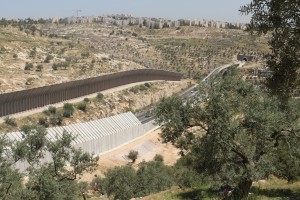
Bypass roads cut up the Palestinian land, with more land lost to Israeli settlements like the one in the distance here (Photos by Bob Haynes).
This morning, we toured the edge of Bethlehem and realized some of the scope of the Wall separating Israel from the West Bank. Zoughbi told us that Israel controls 87% of the Bethlehem area and there are 23 Jewish settlements on the occupied land around Bethlehem. In one area, the Wall is being installed that will take away thousands of acres of fertile agricultural land from Bethlehem. Bypass roads cut through the land, most of them forbidden to Palestinian traffic. The situation is dispiriting. Still, the people we meet here are hopeful for peace to come to this crucible of the world.
We traveled to Hebron and visited the Old City. Near the tomb of Abraham, 400 Jewish settlers
live in a compound guarded by 2000 Israeli soldiers. The Ibrahim Mosque/Synagogue has been divided since Baruch Goldstein massacred 29 Muslims at prayer during Ramadan in 1994 and much of the Old City is forbidden to Palestinians.This afternoon, we were delighted to visit with Mustafa Barghouti, M.D., head of the Palestinian National Initiative and founder of the Palestinian Medical Relief Committee. We talked about the possibility of combining some of the work we are doing in Gaza with work that might be done in the West Bank. Dr. Barghouti’s continual efforts to reconcile differences between political parties in Palestine provide hope for many Palestinians.
His work in the BDS* and non-violent resistance campaigns are markers for Palestinians who seek non-violent methods of seeking peace and justice.*Editor’s Note: In 2005, Palestinian civil society issued a call for a campaign of boycotts, divestment and sanctions (BDS) against Israel until it complies with international law and Palestinian rights.
(Gerri Haynes, a former president of Washington Physicians for Social Responsibility, is once again sending back reports from inside blockaded Gaza. As she did four times before, Gerri has organized a team of doctors and other health care providers to work in hospitals and clinics in Gaza in an effort to directly help the people there and to bring attention to the ongoing humanitarian crisis that the Israeli blockade has created. Eighth in the series.)
As we leave Gaza, we reflect on our brief and full time. Each day was packed with opportunities to work and serve and I am thankful to have traveled with a dedicated and expert group. The passage through Erez is always time consuming. The steps are numerous – from the first taxi ride to the Gaza checkpoints, to the taxi ride between Gaza checkpoints, to the long walk through the open-air tunnel to the Israeli side, the multiple inspections of every item we transport, to the reclaiming and repacking of our suitcases, to passport control and finally, to the van waiting to take us to Bethlehem. Today’s passage was remarkably more rapid than some – from first ride to the van took only four hours – a small portion of the time required for Palestinians who might possibly be able to pass this way for medical care.
We were driven through a winding two-lane road up to the bypass road that leads to Bethlehem. We passed large orchards, vineyards and fields of vegetables – all irrigated from the aquifer common to Israel and Palestine; the aquifer pumped by Israel that thus denies water to Gaza.
In Bethlehem, Zoughbi Zougbhi, director of Wi’am, Palestinian Conflict Resolution Center, welcomed us to his office. There, we enjoyed a spectacular lunch/dinner prepared by his sister-in-law and learned about the community, regional and international conflict resolution work of Wi’am.
We then met with the Water Minister Dr. Simon Al Araj, who re-iterated that of the water available in this area, Israel takes 80%. Additionally, per liter, Palestinians pay substantially more – particularly more than the settlers who live on occupied Palestinian land.This evening, we had a delightful tour of the Holy Family Hospital in Bethlehem. This maternity and infant intensive care hospital serves the entire West Bank. Their Level III nursery takes neonates as young as 28 weeks gestation and has an excellent record of saving lives of very small infants. The hospital has a 20% Caesarean birth rate – lower than the rate in the U.S. – and 100% of the women who give birth here breastfeed their babies.
We were welcomed to the hospital by the CEO, Hussam Wahad. The head physician Dr. Michelle, who, along with his female surgical colleague, led us through the hospital, is from Belgium and serves in this hospital for one week every eight weeks. His gracious demeanor and delightful sense of humor, dedication and respectfulness for the culture were inspiring.
He told stories of his challenges in coming to the region through the airport and checkpoints and his challenges in obtaining essentials such as water. The Head Administrator and Director of Nursing, Sister Maha Sansur, helped us with the tour – showing us again and again that the hospital is a model of technical expertise and care.Tomorrow, we will travel somewhere in the West Bank – learning about the work of people seeking peace in the region.
In reflection on Gaza, Don Mellman wrote: I am a neurosurgeon from Tampa, Florida, who now also does international domestic healthcare policy and management work focused on human rights and am on my third trip to Gaza.
I saw outpatients in the hospital, in outpatient clinics, at their home, and at a makeshift “clinic” at our hotel, The Marna House. I also lectured to surgeons at the large public hospital al Shifa and to fifth and sixth year medical students at the Islamic University of Gaza. I met with the director of the Gaza office of WHO and with leaders of various heath care related NGOs.
(Gerri Haynes, a former president of Washington Physicians for Social Responsibility, is once again sending back reports from inside blockaded Gaza. As she did four times before, Gerri has organized a team of doctors and other health care providers to work in hospitals and clinics in Gaza in an effort to directly help the people there and to bring attention to the ongoing humanitarian crisis that the Israeli blockade has created. Seventh in the series.)
A, whose only daughter died nine months ago at age 13 of lung cancer – believed to be related to toxicity from the Cast Lead attacks. She was the light in her home and her younger brother withdrew completely for months after her death, as he could not be consoled over the loss of his closest sibling.
E, whose husband was killed by a missile during Cast Lead. She is raising their two sons and two daughters. Shortly after her husband died, both of her parents died. She now lives with her husband’s family and describes herself as very patient.
S, whose pregnancy was complicated and a few days after the birth of her daughter, her baby died. Two months later, her mother died. She has three daughters and three sons and grieves the loss of her baby and her mother.
F, whose husband and son were both killed in the same year by Israelis. She says Allah supports us and that she is patient and accepting – raising her five children with very little support.
All of these women describe their children as suffering from the siege: “They can’t concentrate on their studies, they have enuresis, nightmares, are nervous.” One woman described her son as wanting to kill himself. Another said even the most clever children suffer. All worry that more bombing will happen – they live in a constant state of fear.I, whose mother was recently shot by another Palestinian while sitting with her husband outside her home. Political pressure and cultural beliefs were given as reasons for this killing. All the women note that domestic abuse has risen under the pressure of the siege and so few jobs available. One woman described her advanced university degrees and stated there are no jobs available in her area in Gaza.
O, whose father died of throat cancer. Because of the war, he was unable to leave Gaza for the specialized care his disease required. He tried to go out of Gaza into Israel and into Egypt, but by the time he received permission to enter Egypt (many months were consumed), he died.
J, whose brother and four other family members were killed by missiles from Israeli planes during a funeral. Her brother had been asleep and family members awakened him, telling him he had to go to the funeral. He had just arrived at the ceremony when the attack occurred. His wife and five children survived.
G, whose mother refused to leave her home during warnings issued during Cast Lead. Her home was struck by white phosphorus and she subsequently became ill with cancer – which her family strongly attributes to the white phosphorus.W, whose mother had lung fibrosis. She was pregnant and miscarried twins. Because of the siege, she was unable to obtain the medicine she needed. She was hospitalized and died on the Eid.
There are many stories. This morning, I met with a family whose three children died when a candle they were burning tipped over, setting the house aflame. The family said the children had asked for light at night and because electricity is often not available, a candle was provided for them.
The caseworker for this family also told of two brothers who were attempting to connect to the Internet to see a soccer game this week – they somehow touched a power source that surged and electrocuted both of these young men. In one month, in one area of Gaza, there are three incidents of multiple deaths related to the severe problems with electricity.
The women I met with today want the people of the United States to know that they are prisoners in Gaza and that they are suffering greatly from the effects of the siege. They enumerate: electrical power is available for only a few hours and only on some days, jobs are needed, life is expensive, spousal abuse is rising, medical care is difficult to obtain, places are needed for children to play – the list is long and sad and hope is difficult to maintain. Still, I heard again and again that Gaza women are patient and that they are taking the best care of their children that they possibly can.I was received with grace and much affection – I will leave Gaza tomorrow with both joy for having met the people here and great sorrow for the critical situation of life in Gaza.
(Gerri Haynes, a former president of Washington Physicians for Social Responsibility, is once again sending back reports from inside blockaded Gaza. As she did four times before, Gerri has organized a team of doctors and other health care providers to work in hospitals and clinics in Gaza in an effort to directly help the people there and to bring attention to the ongoing humanitarian crisis that the Israeli blockade has created. Sixth in the series.)
Because our schedule has been compressed, we are trying to fit service and meetings into a brief period of time. We are dispersed, learning and working. Rich and Ismael, pediatric urologists are spending their days and long evenings operating on children at two of Gaza’s hospitals. Ahmed Abeid, anesthesiologist is working in operating rooms with Rich and Ismael and teaching in the medical school.
This morning, some members of our group heard from a deputy of the Palestine Center for Human Rights – an organization critical to the mental health of the people of Gaza. Without regard for political affiliation, PCHR serves the rule of law – assisting people in Gaza and the West Bank. Their work focuses not only on Israeli abuses, but on Palestinian Authority and Hamas abuses of the human rights of Palestinian people. They work with many other NGOs including GISHA and Physicians for Human Rights Israel. Following Cast Lead when 1400 people were killed (many of them women and children) and more than 5000 homes were destroyed, PCHR filed 495 civilian cases against Israel. Of all of the well-documented human rights abuses by Israel, only one soldier was held accountable for his actions. He was sentenced to seven months in jail for credit card theft.
Later in the morning, I spoke with the Director of the Women Affairs Center and her assistant about the grief experienced by mothers in Gaza. I heard again that all people of Gaza have been affected by the siege and the violent attacks on the civilians of Gaza. Their grief is complicated by the constant threat of further attacks. I asked them what they would like the people of the United States to know. This is what they replied: “What happens to us is different from anyplace else in the world (they live in a prison with limited access to essential materials of living): How can you imagine in the US or Europe the situation here…we have lack of fuel, it is dark for more than half the day because of the electrical cuts, we cannot do our washing to clean our clothes, we cannot use the computer, we cannot drive our cars or cook our food because of the fuel shortage. All the time, we live in danger. At one time, I cooked by making fire from my children’s books. Cleaning my children’s clothes, my fingers bleed. Most men are without work – there are no opportunities for work. Many young men and women who are promised in marriage do not marry because there is no economy – no place to live together. Palestinian women need peace. We are frustrated – there seems to be no future for us or for our children. No one can live like this.”They spoke of a mother whose son works in the tunnels. (The tunnels connect Egypt and Gaza and more than 200 people have died in the tunnels.) She waits for him every day to come home – always worried because the work is so dangerous, always fearing that someone will knock on her door to tell her that her son has been killed. Her husband has no work and there seems to be no alternative to this tunnel work – no other way to earn money for food.
These women reported that a recent study described that 88.4% of the women in Gaza face economic violence – no money for food, clothing, fuel and no control over the finances of their homes. Culturally, husbands control all finances even when the woman works outside the home. When the husband is unable to find work, the situation is even more complex and violence in the home is a threat.
This afternoon, I worked with mental health professionals from the Gaza Community Mental Health Programme as they evaluated a family whose son was recently killed and whose mother is critically ill. The GCMHP sends teams into homes to complete comprehensive evaluations and then serves individuals and families throughout Gaza. In the current situation, with the constant threat of external and internal trauma, this program is desperately needed. Funding is always needed and international donors are critical to the continuation of their work.
Tonight, we were treated to a spectacular vegetarian dinner in the Al Basheer home – family of Abed, who attends Washington State University, and his wife, Kara. Abed’s father will be coming soon to the United States for help with his vision – we look forward to seeing him again!
(Gerri Haynes, a former president of Washington Physicians for Social Responsibility, is once again sending back reports from inside blockaded Gaza. As she did four times before, Gerri has organized a team of doctors and other health care providers to work in hospitals and clinics in Gaza in an effort to directly help the people there and to bring attention to the ongoing humanitarian crisis that the Israeli blockade has created. Fifth in the series.)
I wish I could send you the sound of the roosters that crow outside our window. One has a strong “roostery” call; the other has an altered and aged sound. As they communicate with one another, the 4am call-to-prayer competes with their conversation – the air is full – another day begins in Gaza.
This morning some members of our group met with an official of the Gaza City Municipality – talking about the possibilities for building a healing garden. He is an architect and teaches in a Gaza university. His enthusiasm about Roxanne’s proposal to include students from his
university and the University of Washington in the planning and construction of a healing garden was wonderful. Roxanne toured some possible garden sites this afternoon – the options are many.We also met with the family of Dr. Abuleish, author of “I Shall Not Hate.” Two of Dr. Abuleish’s daughters and one niece were killed by Israeli tank fire of their house just before the end of Cast Lead (the Israeli attack on Gaza 2008/2009). Another daughter was nearly killed and we met with her today also. Dr. Abuleish’s wife had recently died of cancer and this grieving family’s response to their sadness is part of his story.
This afternoon, we delivered toys, school supplies, toothpaste, toothbrushes and soccer equipment – first to a local kindergarten and then to the orphanage. These gifts, provided by individual donors from Washington and Oregon – including many children – were enthusiastically received!
This afternoon also, I met with a woman whose elderly mother is dying in India. The woman has six children,
her husband has no work and she desperately wants to see her mother before her mother dies. She told me that she prays for someone to “adopt” one of her children – to save the life of one of her children by sending them money each month for food. Presently, her family is hungry. They are eating one meal each day and – the only money the family has comes from the sale of her inexpensive but beautiful handwork.Bob Haynes writes: “I was welcomed back to Al Awda Hospital today by the clinic staff and my cardiologist colleague, Majed Sultan, whom I have worked with for several years. In the midst of the mild chaos of the outside garden waiting area and the more crowded clinic hallways, there exists a gentle code of respect for their elders. In America dutiful daughters often bring their elderly parents to doctor visits. In Gaza, pride and respect, culture and the reality of soaring unemployment, mean that sons bring their parents for medical care. The level of medical expertise is high in Gaza but due to the siege and politics many medical supplies are limited. Additionally, continuing medical education is difficult to acquire – leaving and re-entering
Gaza is arduous and costly.”Steve Gilbert writes: “Underlying the many challenges in Gaza are policy decisions that affect public health. Two of the most glaring which particular effect children are lead and pesticide exposure. I met with Mr. Bahha Alagha at the Environmental Quality Authority and gave a lecture to about 40 people on pesticides. The use and over use of these materials results in ground water contamination, worker exposure, community exposure, and crop contamination with pesticide residue. Worker exposure occurs during mixing and application of organophosphate pesticides. Children are exposed to pesticides tracked into a workers car or home. Chronic infant and childhood exposure to pesticides harms a child’s nervous system and damages their learning and memory abilities. Tracking the amount and types of pesticides used in Gaza is challenging – most of the pesticides move through the Rafah tunnels from Egypt. Programs to provide training in the safe handling of pesticides and integrated pest management principles to
reduce organophosphate class pesticides are needed to protect the futures of Gaza’s children.Leaded gasoline also comes through the tunnels from Egypt into Gaza. This leaded gasoline is cheaper and more available than unleaded gasoline from Israel. Burning of leaded fuel is dangerous. Even low levels of lead exposure can damage the central nervous system. There are well-documented studies regarding the vulnerability of infants and children to even the smallest amount of lead exposure. The United States stopped adding lead to gasoline in the 1980s and childhood blood lead levels have dropped dramatically. We know what the problem is and how to fix it. Protection of children is essential – the use of leaded gasoline and pesticide exposure must be stopped. Children have a right to live in an environment that allows them to reach their full potential. “
(Gerri Haynes, a former president of Washington Physicians for Social Responsibility, is once again sending back reports from inside blockaded Gaza. As she did four times before, Gerri has organized a team of doctors and other health care providers to work in hospitals and clinics in Gaza in an effort to directly help the people there and to bring attention to the ongoing humanitarian crisis that the Israeli blockade has created. Fourth in the series.)
Friday, the day of rest and prayer – hospital clinics and operating rooms are closed. Our friends and their friends joined us as we toured the Strip in a bus – witnessing the beauty and the extreme challenges of this place. Home to 1.7 million people, the 25 mile-long Gaza Strip has some of the most densely populated areas on our planet. Its coastline is lovely – the possibility of a major recreational area is impossible to miss. But flowing into the sea each day are hundreds of thousands of gallons of partially or fully untreated sewage. In places, the strong smell of sewage permeates the air, filling our bus with the awareness that all is not well. At Wadi Gaza (the River Gaza), we see once again the dead body of a large animal – horse or camel – decaying in the sewage near the road – part of the detritus on its way to the sea.On this trip, we were treated to a visit to an archeological dig site – discovered during a road excavation about 17 years ago, in what was a Roman, then Christian, then Muslim area. UNESCO is in charge of the work done here and lovely mosaic tile floors are being carefully restored. When UNESCO recognized Palestine as a state last September and the United States cut funding to UNESCO, the budget for this restoration was decreased, but funding from other countries continued and the work here goes on.
As we traveled south, increased agricultural areas were evident. Approximately 1/3 of the prime agricultural land of Gaza is near the eastern border with Israel and Israel has deemed that land to be in the “security corridor” – crop development there is forbidden so agriculture in other, less fertile areas is increasing. Lack of water is a constant problem. Israel has installed wells along the eastern border and pumps out water that might flow underground to replenish the water supply to Gaza. The increasing population of Gaza demands water, and the aquifer on the western side of the land is being over-used. Seawater is contaminating the water supply – affecting the irrigation of crops as well as water for consumption. UNRWA reports that 90 – 95 percent of the water in Gaza is polluted and unsafe for drinking.In some areas, garbage has been cleaned from the streets – still, the presence of trash along most roads seems to reflect the desperate condition of life here. We saw many closed gas stations and were told again that the amount of fuel for cars, electricity, cooking, and industry has been recently reduced. Because taxes from Gaza have been withheld by the government of Gaza from payment to the Palestinian government in Ramallah and subsequently from
payment to Israel for fuel, only a small amount of fuel is entering Gaza from Israel. Taxes on fuel that comes through the illegal tunnels from Egypt have been substantially increased by Egypt and denied by the government of Gaza. The amount of fuel entering Gaza is insufficient. Fuel that does come through the tunnels contains lead and its use adds danger to the development of children.At the end of our tour, we were treated to magnificent music – piano and song by Ramzy Suleiman, Palestinian American from Washington, D.C. who now lives in Gaza and teaches music at the Edward Said School of Music. The beauty of his music reflected the beauty of the natural land and the wonderful people of Gaza – reminding us that hope for a more just and peaceful future remains.
Roxanne Hamilton, landscape and healing garden designer, joined our delegation for this journey to Gaza, hoping to find interest in the development of a healing garden. In her gentle presentation, she is meeting great enthusiasm for the development of this garden.
Green space is a premium here and the possibility of constructing a place for quiet reflection and healing seems to appeal to everyone we meet. Today, the head of a construction company related his ability and great willingness to help a garden come to reality. We visited the fantastic garden of a local family and witnessed the wide variety of plants that can thrive in this climate.
Before we leave Gaza, Roxanne will have the opportunity to meet with a planning member of the municipality and be able to visit some of the potential sites that Gazans have recommended for a garden.
Michael Poage, Bob Haynes, Roxanne Hamilton and Steve Gilbert visited an orphanage in Gaza. This immaculate facility is home to 100 children, 5 – 18 years of age. A second orphanage in Rafah also has 100 permanent residents. Another 15,000 orphans in Gaza live with extended families.All of the children who live in the orphanages attend local schools and receive intensive care from the orphanage staff: tutoring, birthday parties, holiday celebrations and psychological counseling. Recently, some recreational activities have been curtailed due to budget shortfalls. In the dire economy of Gaza, all people suffer.
Bob Haynes and Don Mellman consulted on patients in their specialty areas, cardiology and neurosurgery. Don also gave a lecture focusing on courage to fourth year medical students and Laura Hart spoke about urology in a local hospital.
This evening, we were visited by friends from previous trips – women who have committed their lives to serving Gaza – a UN worker, an NGO staffer and a pharmacist – all extremely bright and well-educated. Amani Malwan, who helped us with complex logistics during our last visits, presented us with a photo cake depicting one of our delegations.Having the opportunity to hear about the response of these young women to life under external occupation is inspiring – each woman is helping Gaza to survive.
